Tesa UK Ltd: Strategies for Business Communication in Brazil
VerifiedAdded on 2023/06/18
|10
|3305
|273
Report
AI Summary
This report delves into the intricacies of international business communication in Brazil, specifically focusing on the potential establishment of Tesa UK Ltd. The analysis covers Brazil's economic landscape, cultural nuances, and the application of international and intercultural communication theories such as Hofstede's model, Samovar model, and Jandt theory. It highlights the importance of cultural sensitivity, potential communication barriers like language differences and trust issues, and recommends tailored communication strategies for Tesa UK Ltd to navigate the Brazilian market effectively. The report emphasizes building strong relationships with customers, adapting to local communication styles, and leveraging cultural diversity within the organization to ensure successful business operations in Brazil. Desklib provides access to similar solved assignments and past papers for students.
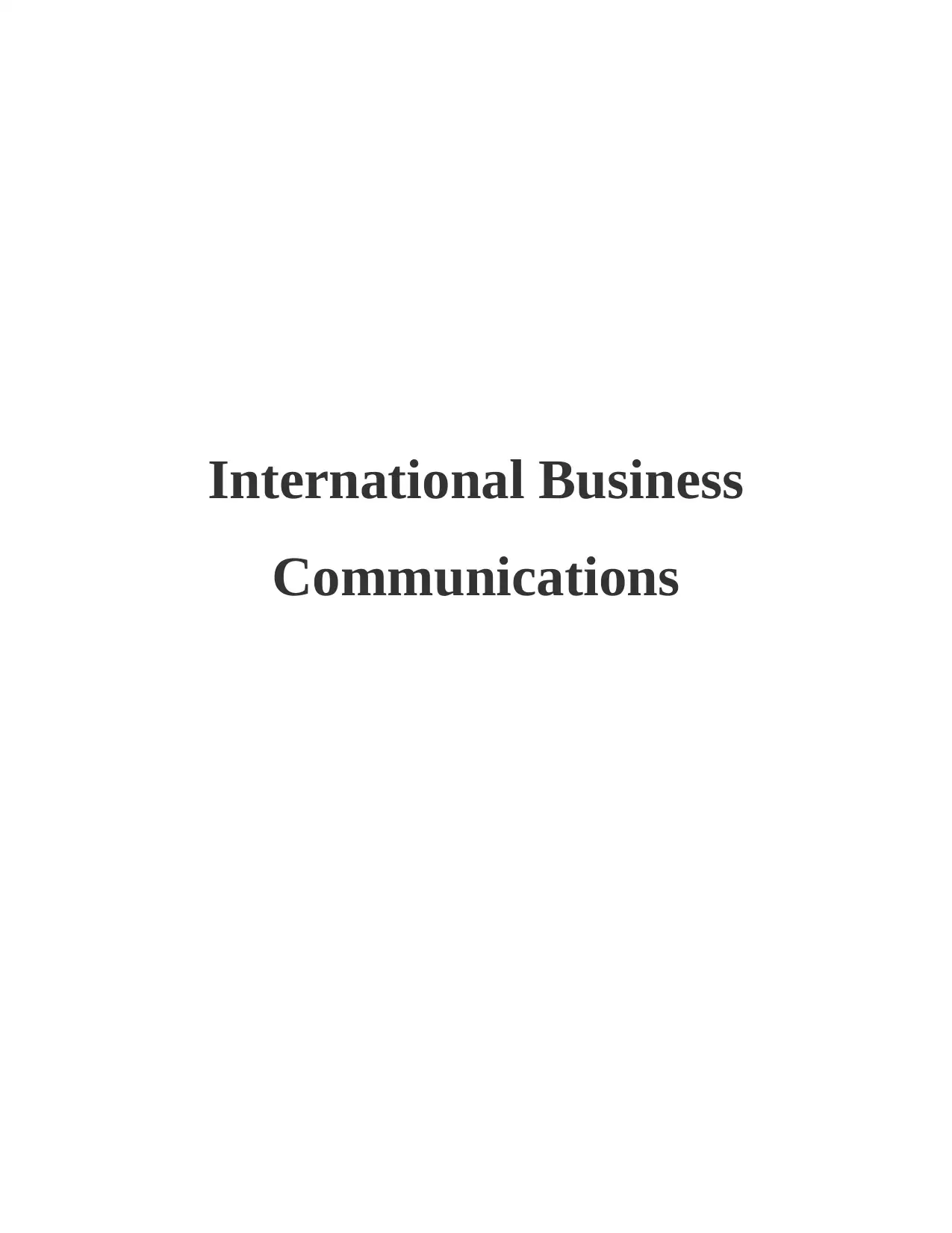
International Business
Communications
Communications
Paraphrase This Document
Need a fresh take? Get an instant paraphrase of this document with our AI Paraphraser
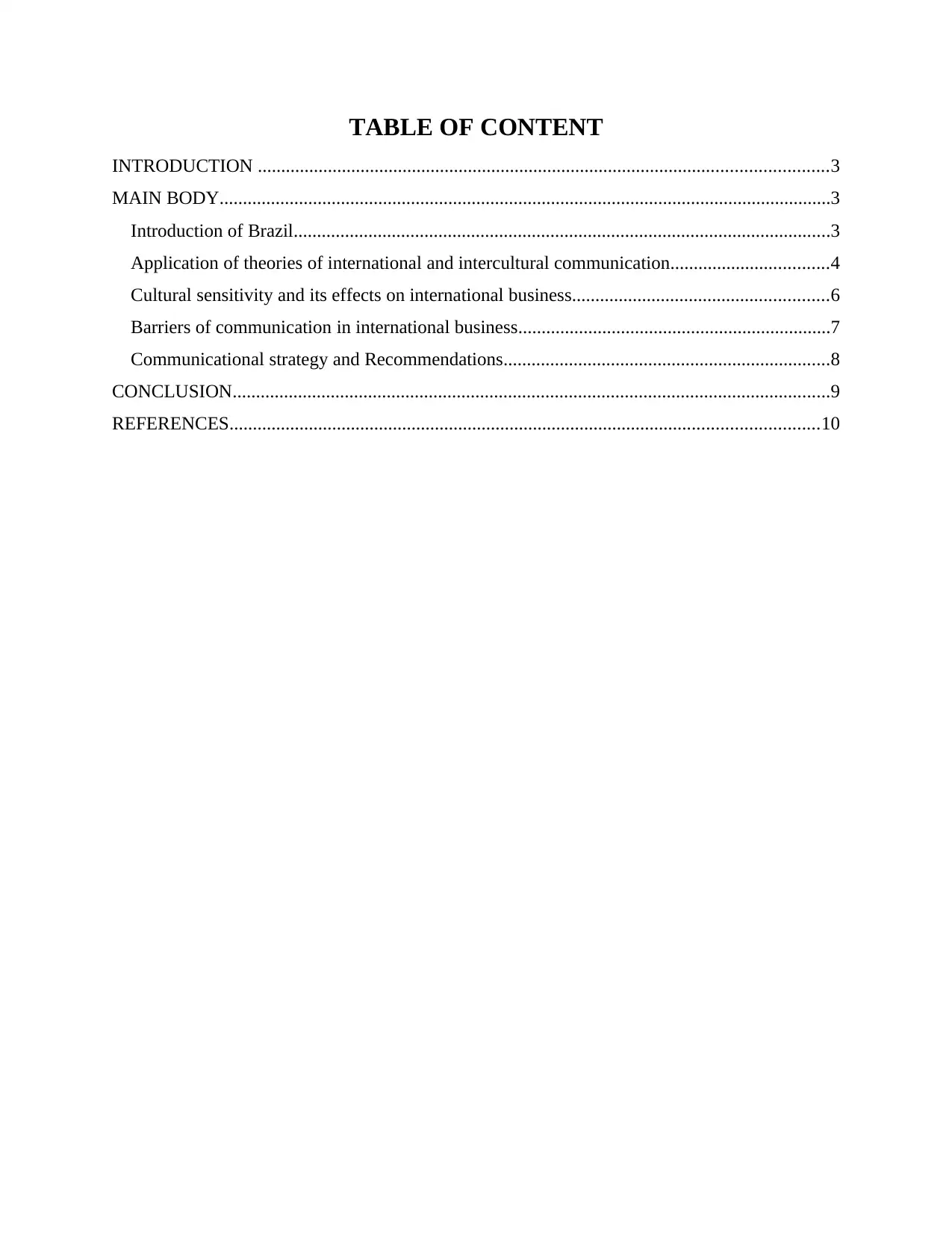
TABLE OF CONTENT
INTRODUCTION ..........................................................................................................................3
MAIN BODY...................................................................................................................................3
Introduction of Brazil...................................................................................................................3
Application of theories of international and intercultural communication..................................4
Cultural sensitivity and its effects on international business.......................................................6
Barriers of communication in international business...................................................................7
Communicational strategy and Recommendations......................................................................8
CONCLUSION................................................................................................................................9
REFERENCES..............................................................................................................................10
INTRODUCTION ..........................................................................................................................3
MAIN BODY...................................................................................................................................3
Introduction of Brazil...................................................................................................................3
Application of theories of international and intercultural communication..................................4
Cultural sensitivity and its effects on international business.......................................................6
Barriers of communication in international business...................................................................7
Communicational strategy and Recommendations......................................................................8
CONCLUSION................................................................................................................................9
REFERENCES..............................................................................................................................10
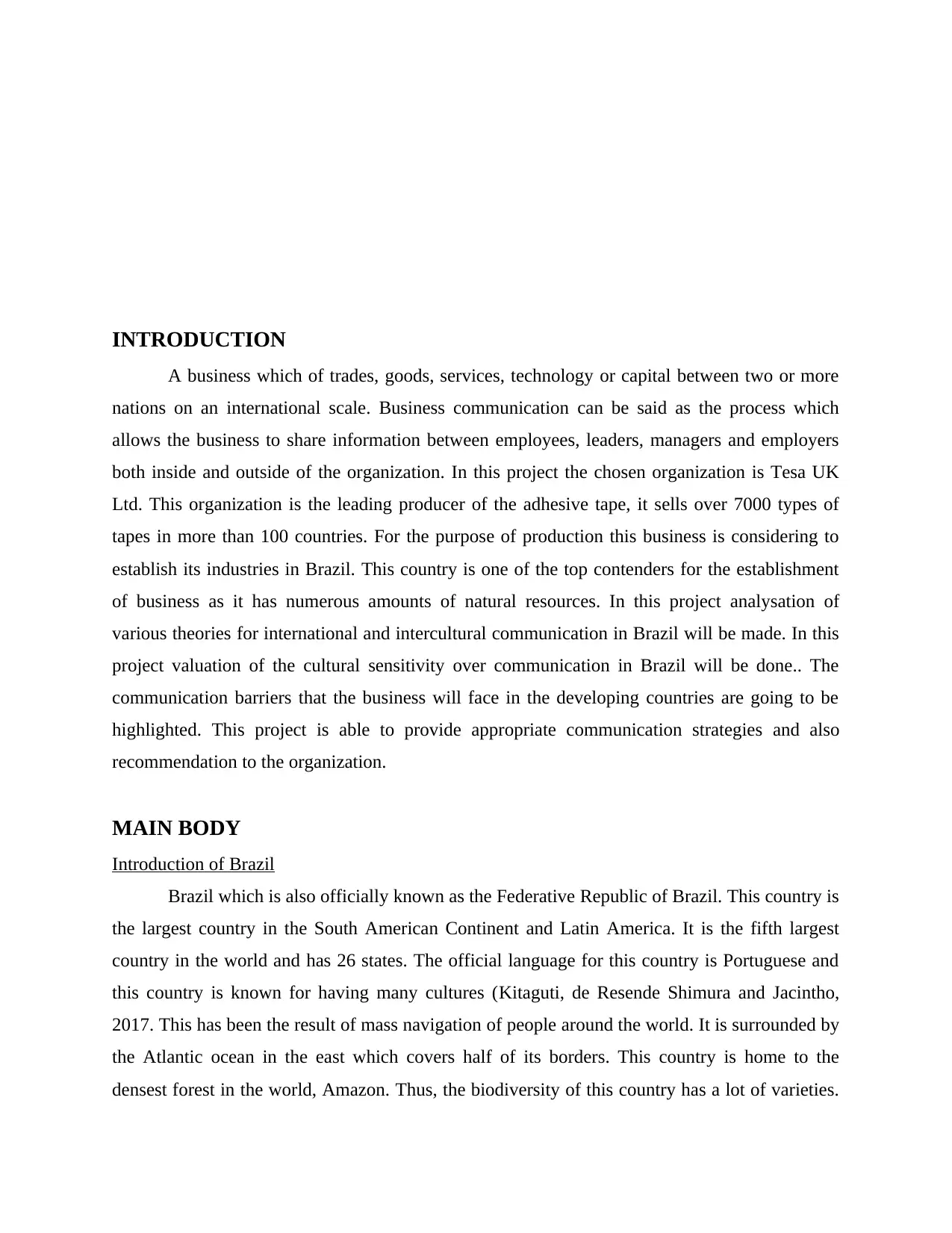
INTRODUCTION
A business which of trades, goods, services, technology or capital between two or more
nations on an international scale. Business communication can be said as the process which
allows the business to share information between employees, leaders, managers and employers
both inside and outside of the organization. In this project the chosen organization is Tesa UK
Ltd. This organization is the leading producer of the adhesive tape, it sells over 7000 types of
tapes in more than 100 countries. For the purpose of production this business is considering to
establish its industries in Brazil. This country is one of the top contenders for the establishment
of business as it has numerous amounts of natural resources. In this project analysation of
various theories for international and intercultural communication in Brazil will be made. In this
project valuation of the cultural sensitivity over communication in Brazil will be done.. The
communication barriers that the business will face in the developing countries are going to be
highlighted. This project is able to provide appropriate communication strategies and also
recommendation to the organization.
MAIN BODY
Introduction of Brazil
Brazil which is also officially known as the Federative Republic of Brazil. This country is
the largest country in the South American Continent and Latin America. It is the fifth largest
country in the world and has 26 states. The official language for this country is Portuguese and
this country is known for having many cultures (Kitaguti, de Resende Shimura and Jacintho,
2017. This has been the result of mass navigation of people around the world. It is surrounded by
the Atlantic ocean in the east which covers half of its borders. This country is home to the
densest forest in the world, Amazon. Thus, the biodiversity of this country has a lot of varieties.
A business which of trades, goods, services, technology or capital between two or more
nations on an international scale. Business communication can be said as the process which
allows the business to share information between employees, leaders, managers and employers
both inside and outside of the organization. In this project the chosen organization is Tesa UK
Ltd. This organization is the leading producer of the adhesive tape, it sells over 7000 types of
tapes in more than 100 countries. For the purpose of production this business is considering to
establish its industries in Brazil. This country is one of the top contenders for the establishment
of business as it has numerous amounts of natural resources. In this project analysation of
various theories for international and intercultural communication in Brazil will be made. In this
project valuation of the cultural sensitivity over communication in Brazil will be done.. The
communication barriers that the business will face in the developing countries are going to be
highlighted. This project is able to provide appropriate communication strategies and also
recommendation to the organization.
MAIN BODY
Introduction of Brazil
Brazil which is also officially known as the Federative Republic of Brazil. This country is
the largest country in the South American Continent and Latin America. It is the fifth largest
country in the world and has 26 states. The official language for this country is Portuguese and
this country is known for having many cultures (Kitaguti, de Resende Shimura and Jacintho,
2017. This has been the result of mass navigation of people around the world. It is surrounded by
the Atlantic ocean in the east which covers half of its borders. This country is home to the
densest forest in the world, Amazon. Thus, the biodiversity of this country has a lot of varieties.
⊘ This is a preview!⊘
Do you want full access?
Subscribe today to unlock all pages.

Trusted by 1+ million students worldwide
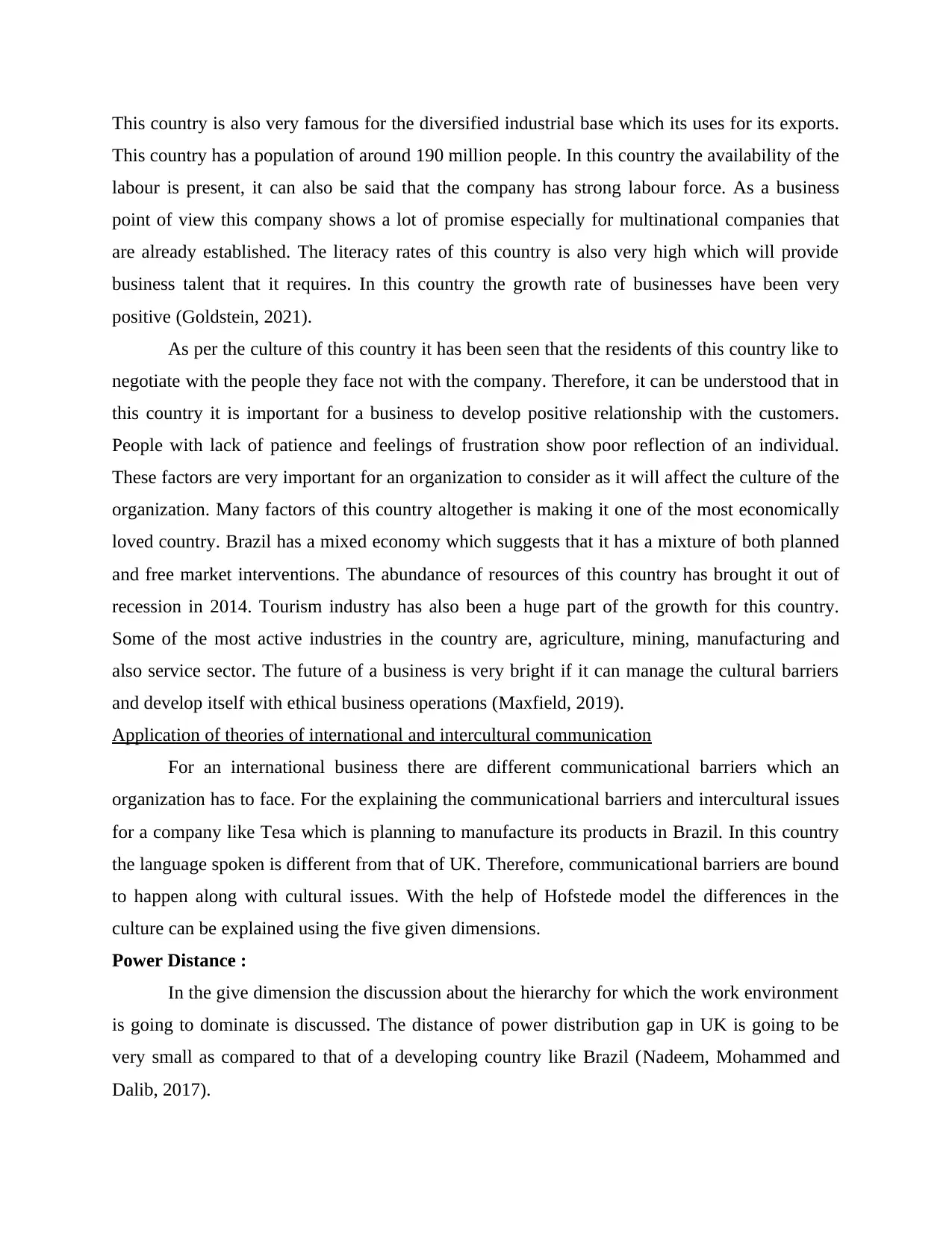
This country is also very famous for the diversified industrial base which its uses for its exports.
This country has a population of around 190 million people. In this country the availability of the
labour is present, it can also be said that the company has strong labour force. As a business
point of view this company shows a lot of promise especially for multinational companies that
are already established. The literacy rates of this country is also very high which will provide
business talent that it requires. In this country the growth rate of businesses have been very
positive (Goldstein, 2021).
As per the culture of this country it has been seen that the residents of this country like to
negotiate with the people they face not with the company. Therefore, it can be understood that in
this country it is important for a business to develop positive relationship with the customers.
People with lack of patience and feelings of frustration show poor reflection of an individual.
These factors are very important for an organization to consider as it will affect the culture of the
organization. Many factors of this country altogether is making it one of the most economically
loved country. Brazil has a mixed economy which suggests that it has a mixture of both planned
and free market interventions. The abundance of resources of this country has brought it out of
recession in 2014. Tourism industry has also been a huge part of the growth for this country.
Some of the most active industries in the country are, agriculture, mining, manufacturing and
also service sector. The future of a business is very bright if it can manage the cultural barriers
and develop itself with ethical business operations (Maxfield, 2019).
Application of theories of international and intercultural communication
For an international business there are different communicational barriers which an
organization has to face. For the explaining the communicational barriers and intercultural issues
for a company like Tesa which is planning to manufacture its products in Brazil. In this country
the language spoken is different from that of UK. Therefore, communicational barriers are bound
to happen along with cultural issues. With the help of Hofstede model the differences in the
culture can be explained using the five given dimensions.
Power Distance :
In the give dimension the discussion about the hierarchy for which the work environment
is going to dominate is discussed. The distance of power distribution gap in UK is going to be
very small as compared to that of a developing country like Brazil (Nadeem, Mohammed and
Dalib, 2017).
This country has a population of around 190 million people. In this country the availability of the
labour is present, it can also be said that the company has strong labour force. As a business
point of view this company shows a lot of promise especially for multinational companies that
are already established. The literacy rates of this country is also very high which will provide
business talent that it requires. In this country the growth rate of businesses have been very
positive (Goldstein, 2021).
As per the culture of this country it has been seen that the residents of this country like to
negotiate with the people they face not with the company. Therefore, it can be understood that in
this country it is important for a business to develop positive relationship with the customers.
People with lack of patience and feelings of frustration show poor reflection of an individual.
These factors are very important for an organization to consider as it will affect the culture of the
organization. Many factors of this country altogether is making it one of the most economically
loved country. Brazil has a mixed economy which suggests that it has a mixture of both planned
and free market interventions. The abundance of resources of this country has brought it out of
recession in 2014. Tourism industry has also been a huge part of the growth for this country.
Some of the most active industries in the country are, agriculture, mining, manufacturing and
also service sector. The future of a business is very bright if it can manage the cultural barriers
and develop itself with ethical business operations (Maxfield, 2019).
Application of theories of international and intercultural communication
For an international business there are different communicational barriers which an
organization has to face. For the explaining the communicational barriers and intercultural issues
for a company like Tesa which is planning to manufacture its products in Brazil. In this country
the language spoken is different from that of UK. Therefore, communicational barriers are bound
to happen along with cultural issues. With the help of Hofstede model the differences in the
culture can be explained using the five given dimensions.
Power Distance :
In the give dimension the discussion about the hierarchy for which the work environment
is going to dominate is discussed. The distance of power distribution gap in UK is going to be
very small as compared to that of a developing country like Brazil (Nadeem, Mohammed and
Dalib, 2017).
Paraphrase This Document
Need a fresh take? Get an instant paraphrase of this document with our AI Paraphraser
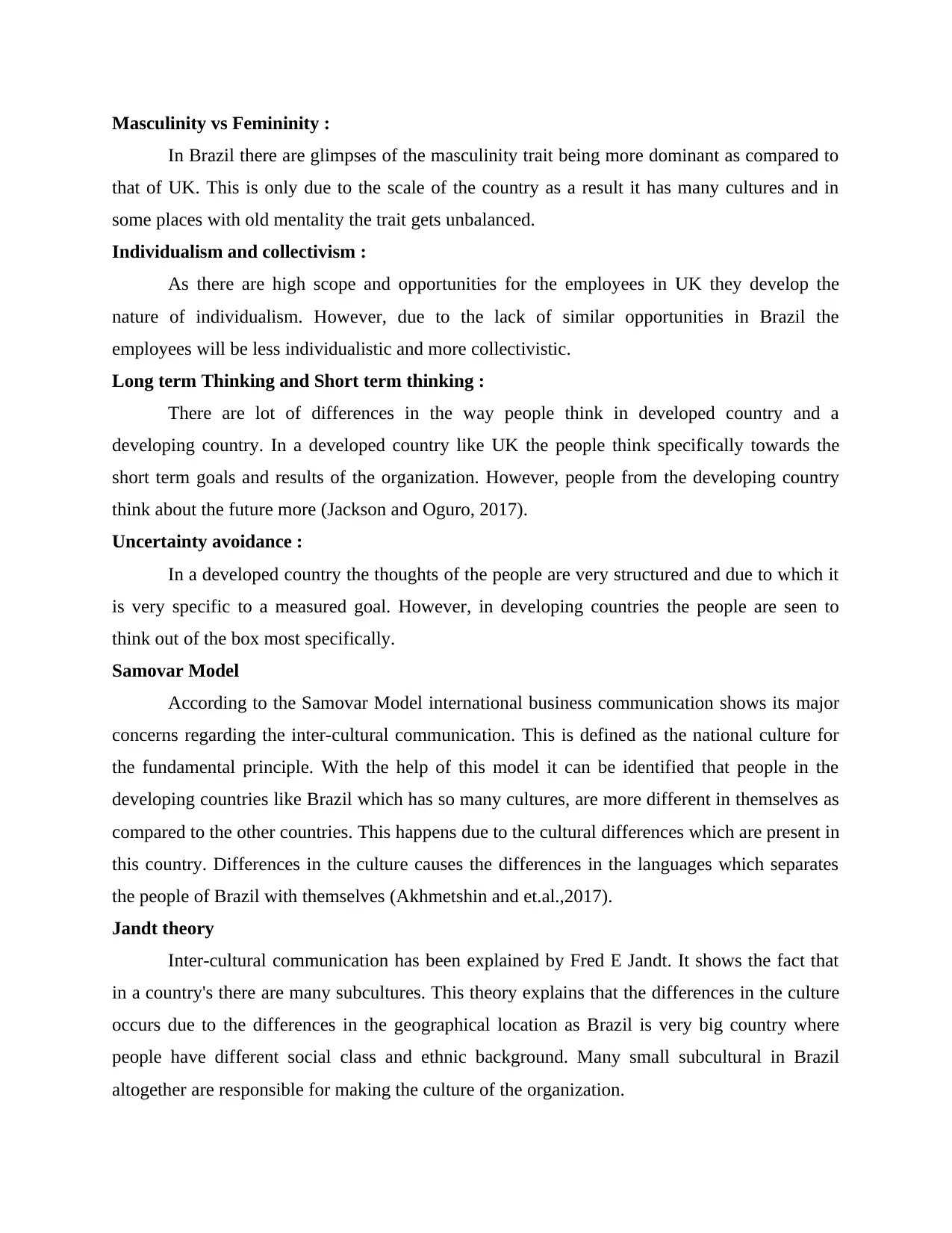
Masculinity vs Femininity :
In Brazil there are glimpses of the masculinity trait being more dominant as compared to
that of UK. This is only due to the scale of the country as a result it has many cultures and in
some places with old mentality the trait gets unbalanced.
Individualism and collectivism :
As there are high scope and opportunities for the employees in UK they develop the
nature of individualism. However, due to the lack of similar opportunities in Brazil the
employees will be less individualistic and more collectivistic.
Long term Thinking and Short term thinking :
There are lot of differences in the way people think in developed country and a
developing country. In a developed country like UK the people think specifically towards the
short term goals and results of the organization. However, people from the developing country
think about the future more (Jackson and Oguro, 2017).
Uncertainty avoidance :
In a developed country the thoughts of the people are very structured and due to which it
is very specific to a measured goal. However, in developing countries the people are seen to
think out of the box most specifically.
Samovar Model
According to the Samovar Model international business communication shows its major
concerns regarding the inter-cultural communication. This is defined as the national culture for
the fundamental principle. With the help of this model it can be identified that people in the
developing countries like Brazil which has so many cultures, are more different in themselves as
compared to the other countries. This happens due to the cultural differences which are present in
this country. Differences in the culture causes the differences in the languages which separates
the people of Brazil with themselves (Akhmetshin and et.al.,2017).
Jandt theory
Inter-cultural communication has been explained by Fred E Jandt. It shows the fact that
in a country's there are many subcultures. This theory explains that the differences in the culture
occurs due to the differences in the geographical location as Brazil is very big country where
people have different social class and ethnic background. Many small subcultural in Brazil
altogether are responsible for making the culture of the organization.
In Brazil there are glimpses of the masculinity trait being more dominant as compared to
that of UK. This is only due to the scale of the country as a result it has many cultures and in
some places with old mentality the trait gets unbalanced.
Individualism and collectivism :
As there are high scope and opportunities for the employees in UK they develop the
nature of individualism. However, due to the lack of similar opportunities in Brazil the
employees will be less individualistic and more collectivistic.
Long term Thinking and Short term thinking :
There are lot of differences in the way people think in developed country and a
developing country. In a developed country like UK the people think specifically towards the
short term goals and results of the organization. However, people from the developing country
think about the future more (Jackson and Oguro, 2017).
Uncertainty avoidance :
In a developed country the thoughts of the people are very structured and due to which it
is very specific to a measured goal. However, in developing countries the people are seen to
think out of the box most specifically.
Samovar Model
According to the Samovar Model international business communication shows its major
concerns regarding the inter-cultural communication. This is defined as the national culture for
the fundamental principle. With the help of this model it can be identified that people in the
developing countries like Brazil which has so many cultures, are more different in themselves as
compared to the other countries. This happens due to the cultural differences which are present in
this country. Differences in the culture causes the differences in the languages which separates
the people of Brazil with themselves (Akhmetshin and et.al.,2017).
Jandt theory
Inter-cultural communication has been explained by Fred E Jandt. It shows the fact that
in a country's there are many subcultures. This theory explains that the differences in the culture
occurs due to the differences in the geographical location as Brazil is very big country where
people have different social class and ethnic background. Many small subcultural in Brazil
altogether are responsible for making the culture of the organization.
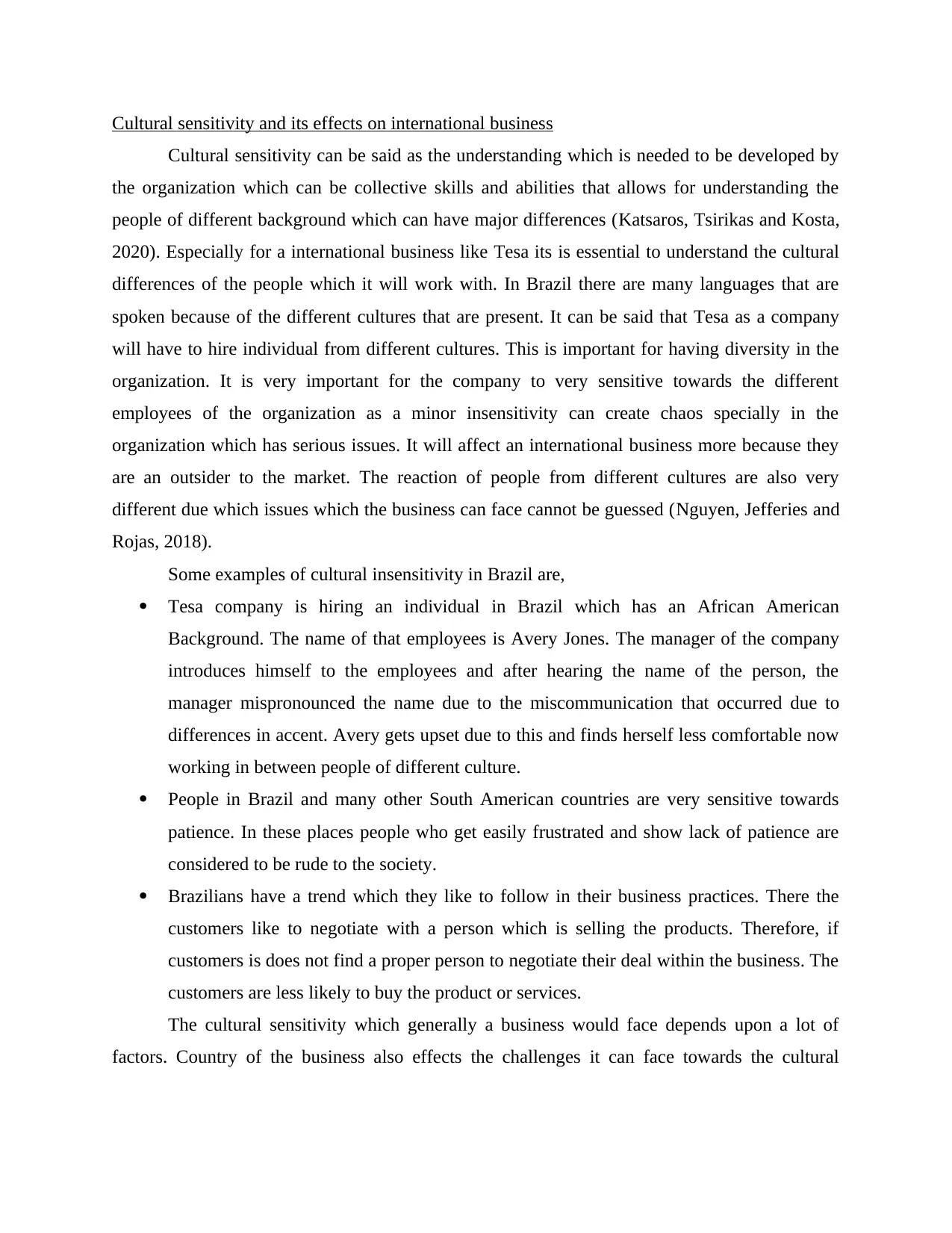
Cultural sensitivity and its effects on international business
Cultural sensitivity can be said as the understanding which is needed to be developed by
the organization which can be collective skills and abilities that allows for understanding the
people of different background which can have major differences (Katsaros, Tsirikas and Kosta,
2020). Especially for a international business like Tesa its is essential to understand the cultural
differences of the people which it will work with. In Brazil there are many languages that are
spoken because of the different cultures that are present. It can be said that Tesa as a company
will have to hire individual from different cultures. This is important for having diversity in the
organization. It is very important for the company to very sensitive towards the different
employees of the organization as a minor insensitivity can create chaos specially in the
organization which has serious issues. It will affect an international business more because they
are an outsider to the market. The reaction of people from different cultures are also very
different due which issues which the business can face cannot be guessed (Nguyen, Jefferies and
Rojas, 2018).
Some examples of cultural insensitivity in Brazil are,
Tesa company is hiring an individual in Brazil which has an African American
Background. The name of that employees is Avery Jones. The manager of the company
introduces himself to the employees and after hearing the name of the person, the
manager mispronounced the name due to the miscommunication that occurred due to
differences in accent. Avery gets upset due to this and finds herself less comfortable now
working in between people of different culture.
People in Brazil and many other South American countries are very sensitive towards
patience. In these places people who get easily frustrated and show lack of patience are
considered to be rude to the society.
Brazilians have a trend which they like to follow in their business practices. There the
customers like to negotiate with a person which is selling the products. Therefore, if
customers is does not find a proper person to negotiate their deal within the business. The
customers are less likely to buy the product or services.
The cultural sensitivity which generally a business would face depends upon a lot of
factors. Country of the business also effects the challenges it can face towards the cultural
Cultural sensitivity can be said as the understanding which is needed to be developed by
the organization which can be collective skills and abilities that allows for understanding the
people of different background which can have major differences (Katsaros, Tsirikas and Kosta,
2020). Especially for a international business like Tesa its is essential to understand the cultural
differences of the people which it will work with. In Brazil there are many languages that are
spoken because of the different cultures that are present. It can be said that Tesa as a company
will have to hire individual from different cultures. This is important for having diversity in the
organization. It is very important for the company to very sensitive towards the different
employees of the organization as a minor insensitivity can create chaos specially in the
organization which has serious issues. It will affect an international business more because they
are an outsider to the market. The reaction of people from different cultures are also very
different due which issues which the business can face cannot be guessed (Nguyen, Jefferies and
Rojas, 2018).
Some examples of cultural insensitivity in Brazil are,
Tesa company is hiring an individual in Brazil which has an African American
Background. The name of that employees is Avery Jones. The manager of the company
introduces himself to the employees and after hearing the name of the person, the
manager mispronounced the name due to the miscommunication that occurred due to
differences in accent. Avery gets upset due to this and finds herself less comfortable now
working in between people of different culture.
People in Brazil and many other South American countries are very sensitive towards
patience. In these places people who get easily frustrated and show lack of patience are
considered to be rude to the society.
Brazilians have a trend which they like to follow in their business practices. There the
customers like to negotiate with a person which is selling the products. Therefore, if
customers is does not find a proper person to negotiate their deal within the business. The
customers are less likely to buy the product or services.
The cultural sensitivity which generally a business would face depends upon a lot of
factors. Country of the business also effects the challenges it can face towards the cultural
⊘ This is a preview!⊘
Do you want full access?
Subscribe today to unlock all pages.

Trusted by 1+ million students worldwide
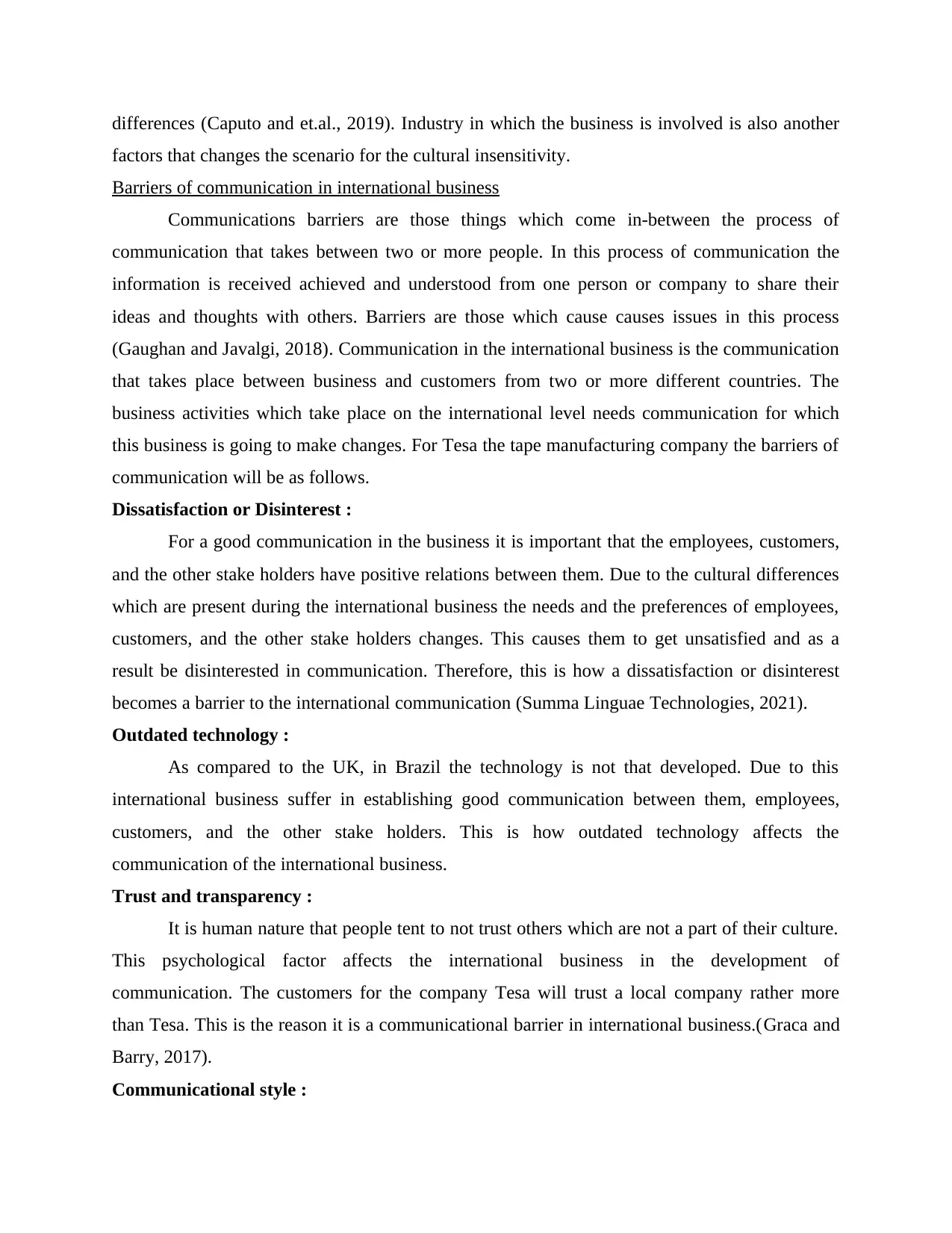
differences (Caputo and et.al., 2019). Industry in which the business is involved is also another
factors that changes the scenario for the cultural insensitivity.
Barriers of communication in international business
Communications barriers are those things which come in-between the process of
communication that takes between two or more people. In this process of communication the
information is received achieved and understood from one person or company to share their
ideas and thoughts with others. Barriers are those which cause causes issues in this process
(Gaughan and Javalgi, 2018). Communication in the international business is the communication
that takes place between business and customers from two or more different countries. The
business activities which take place on the international level needs communication for which
this business is going to make changes. For Tesa the tape manufacturing company the barriers of
communication will be as follows.
Dissatisfaction or Disinterest :
For a good communication in the business it is important that the employees, customers,
and the other stake holders have positive relations between them. Due to the cultural differences
which are present during the international business the needs and the preferences of employees,
customers, and the other stake holders changes. This causes them to get unsatisfied and as a
result be disinterested in communication. Therefore, this is how a dissatisfaction or disinterest
becomes a barrier to the international communication (Summa Linguae Technologies, 2021).
Outdated technology :
As compared to the UK, in Brazil the technology is not that developed. Due to this
international business suffer in establishing good communication between them, employees,
customers, and the other stake holders. This is how outdated technology affects the
communication of the international business.
Trust and transparency :
It is human nature that people tent to not trust others which are not a part of their culture.
This psychological factor affects the international business in the development of
communication. The customers for the company Tesa will trust a local company rather more
than Tesa. This is the reason it is a communicational barrier in international business.(Graca and
Barry, 2017).
Communicational style :
factors that changes the scenario for the cultural insensitivity.
Barriers of communication in international business
Communications barriers are those things which come in-between the process of
communication that takes between two or more people. In this process of communication the
information is received achieved and understood from one person or company to share their
ideas and thoughts with others. Barriers are those which cause causes issues in this process
(Gaughan and Javalgi, 2018). Communication in the international business is the communication
that takes place between business and customers from two or more different countries. The
business activities which take place on the international level needs communication for which
this business is going to make changes. For Tesa the tape manufacturing company the barriers of
communication will be as follows.
Dissatisfaction or Disinterest :
For a good communication in the business it is important that the employees, customers,
and the other stake holders have positive relations between them. Due to the cultural differences
which are present during the international business the needs and the preferences of employees,
customers, and the other stake holders changes. This causes them to get unsatisfied and as a
result be disinterested in communication. Therefore, this is how a dissatisfaction or disinterest
becomes a barrier to the international communication (Summa Linguae Technologies, 2021).
Outdated technology :
As compared to the UK, in Brazil the technology is not that developed. Due to this
international business suffer in establishing good communication between them, employees,
customers, and the other stake holders. This is how outdated technology affects the
communication of the international business.
Trust and transparency :
It is human nature that people tent to not trust others which are not a part of their culture.
This psychological factor affects the international business in the development of
communication. The customers for the company Tesa will trust a local company rather more
than Tesa. This is the reason it is a communicational barrier in international business.(Graca and
Barry, 2017).
Communicational style :
Paraphrase This Document
Need a fresh take? Get an instant paraphrase of this document with our AI Paraphraser
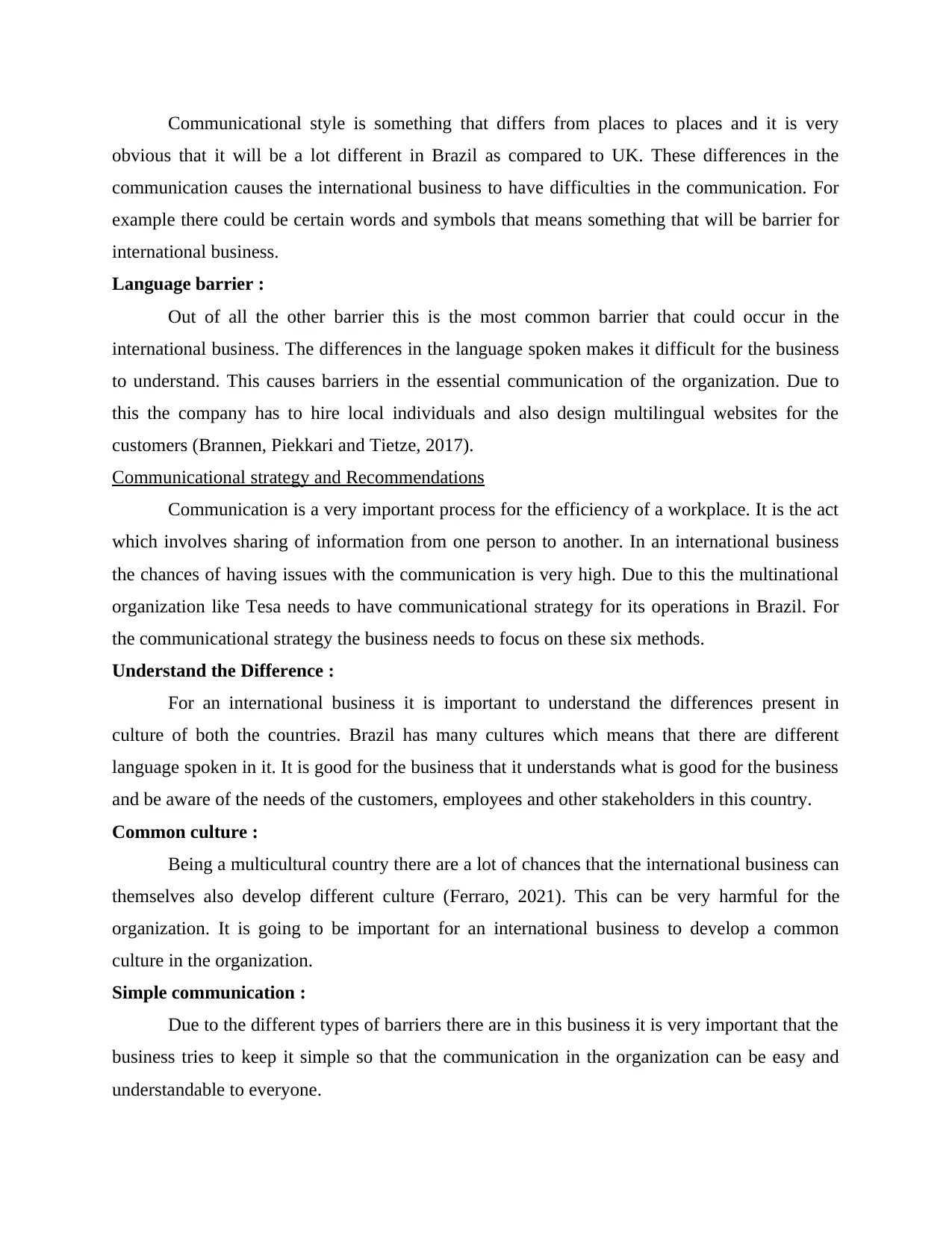
Communicational style is something that differs from places to places and it is very
obvious that it will be a lot different in Brazil as compared to UK. These differences in the
communication causes the international business to have difficulties in the communication. For
example there could be certain words and symbols that means something that will be barrier for
international business.
Language barrier :
Out of all the other barrier this is the most common barrier that could occur in the
international business. The differences in the language spoken makes it difficult for the business
to understand. This causes barriers in the essential communication of the organization. Due to
this the company has to hire local individuals and also design multilingual websites for the
customers (Brannen, Piekkari and Tietze, 2017).
Communicational strategy and Recommendations
Communication is a very important process for the efficiency of a workplace. It is the act
which involves sharing of information from one person to another. In an international business
the chances of having issues with the communication is very high. Due to this the multinational
organization like Tesa needs to have communicational strategy for its operations in Brazil. For
the communicational strategy the business needs to focus on these six methods.
Understand the Difference :
For an international business it is important to understand the differences present in
culture of both the countries. Brazil has many cultures which means that there are different
language spoken in it. It is good for the business that it understands what is good for the business
and be aware of the needs of the customers, employees and other stakeholders in this country.
Common culture :
Being a multicultural country there are a lot of chances that the international business can
themselves also develop different culture (Ferraro, 2021). This can be very harmful for the
organization. It is going to be important for an international business to develop a common
culture in the organization.
Simple communication :
Due to the different types of barriers there are in this business it is very important that the
business tries to keep it simple so that the communication in the organization can be easy and
understandable to everyone.
obvious that it will be a lot different in Brazil as compared to UK. These differences in the
communication causes the international business to have difficulties in the communication. For
example there could be certain words and symbols that means something that will be barrier for
international business.
Language barrier :
Out of all the other barrier this is the most common barrier that could occur in the
international business. The differences in the language spoken makes it difficult for the business
to understand. This causes barriers in the essential communication of the organization. Due to
this the company has to hire local individuals and also design multilingual websites for the
customers (Brannen, Piekkari and Tietze, 2017).
Communicational strategy and Recommendations
Communication is a very important process for the efficiency of a workplace. It is the act
which involves sharing of information from one person to another. In an international business
the chances of having issues with the communication is very high. Due to this the multinational
organization like Tesa needs to have communicational strategy for its operations in Brazil. For
the communicational strategy the business needs to focus on these six methods.
Understand the Difference :
For an international business it is important to understand the differences present in
culture of both the countries. Brazil has many cultures which means that there are different
language spoken in it. It is good for the business that it understands what is good for the business
and be aware of the needs of the customers, employees and other stakeholders in this country.
Common culture :
Being a multicultural country there are a lot of chances that the international business can
themselves also develop different culture (Ferraro, 2021). This can be very harmful for the
organization. It is going to be important for an international business to develop a common
culture in the organization.
Simple communication :
Due to the different types of barriers there are in this business it is very important that the
business tries to keep it simple so that the communication in the organization can be easy and
understandable to everyone.
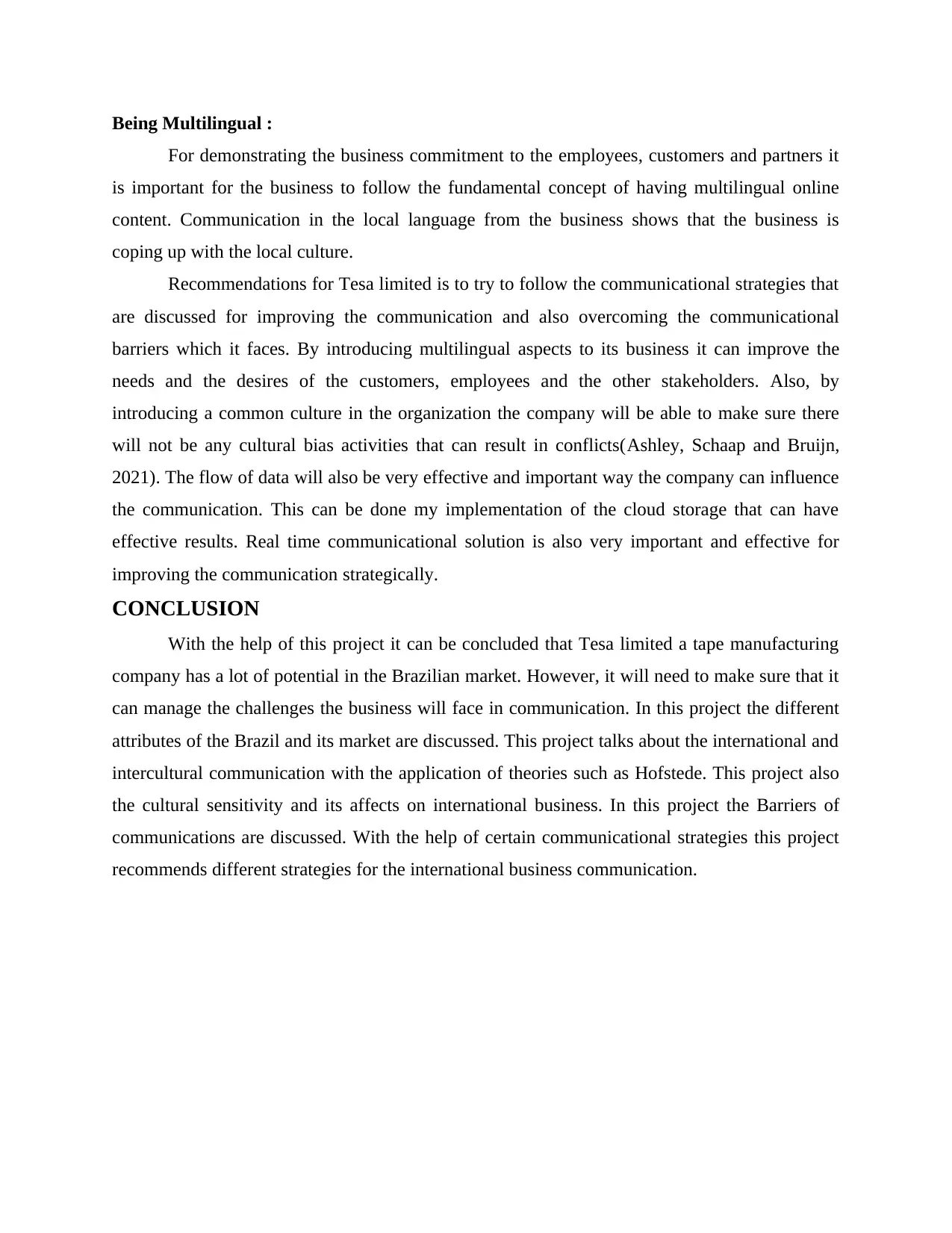
Being Multilingual :
For demonstrating the business commitment to the employees, customers and partners it
is important for the business to follow the fundamental concept of having multilingual online
content. Communication in the local language from the business shows that the business is
coping up with the local culture.
Recommendations for Tesa limited is to try to follow the communicational strategies that
are discussed for improving the communication and also overcoming the communicational
barriers which it faces. By introducing multilingual aspects to its business it can improve the
needs and the desires of the customers, employees and the other stakeholders. Also, by
introducing a common culture in the organization the company will be able to make sure there
will not be any cultural bias activities that can result in conflicts(Ashley, Schaap and Bruijn,
2021). The flow of data will also be very effective and important way the company can influence
the communication. This can be done my implementation of the cloud storage that can have
effective results. Real time communicational solution is also very important and effective for
improving the communication strategically.
CONCLUSION
With the help of this project it can be concluded that Tesa limited a tape manufacturing
company has a lot of potential in the Brazilian market. However, it will need to make sure that it
can manage the challenges the business will face in communication. In this project the different
attributes of the Brazil and its market are discussed. This project talks about the international and
intercultural communication with the application of theories such as Hofstede. This project also
the cultural sensitivity and its affects on international business. In this project the Barriers of
communications are discussed. With the help of certain communicational strategies this project
recommends different strategies for the international business communication.
For demonstrating the business commitment to the employees, customers and partners it
is important for the business to follow the fundamental concept of having multilingual online
content. Communication in the local language from the business shows that the business is
coping up with the local culture.
Recommendations for Tesa limited is to try to follow the communicational strategies that
are discussed for improving the communication and also overcoming the communicational
barriers which it faces. By introducing multilingual aspects to its business it can improve the
needs and the desires of the customers, employees and the other stakeholders. Also, by
introducing a common culture in the organization the company will be able to make sure there
will not be any cultural bias activities that can result in conflicts(Ashley, Schaap and Bruijn,
2021). The flow of data will also be very effective and important way the company can influence
the communication. This can be done my implementation of the cloud storage that can have
effective results. Real time communicational solution is also very important and effective for
improving the communication strategically.
CONCLUSION
With the help of this project it can be concluded that Tesa limited a tape manufacturing
company has a lot of potential in the Brazilian market. However, it will need to make sure that it
can manage the challenges the business will face in communication. In this project the different
attributes of the Brazil and its market are discussed. This project talks about the international and
intercultural communication with the application of theories such as Hofstede. This project also
the cultural sensitivity and its affects on international business. In this project the Barriers of
communications are discussed. With the help of certain communicational strategies this project
recommends different strategies for the international business communication.
⊘ This is a preview!⊘
Do you want full access?
Subscribe today to unlock all pages.

Trusted by 1+ million students worldwide
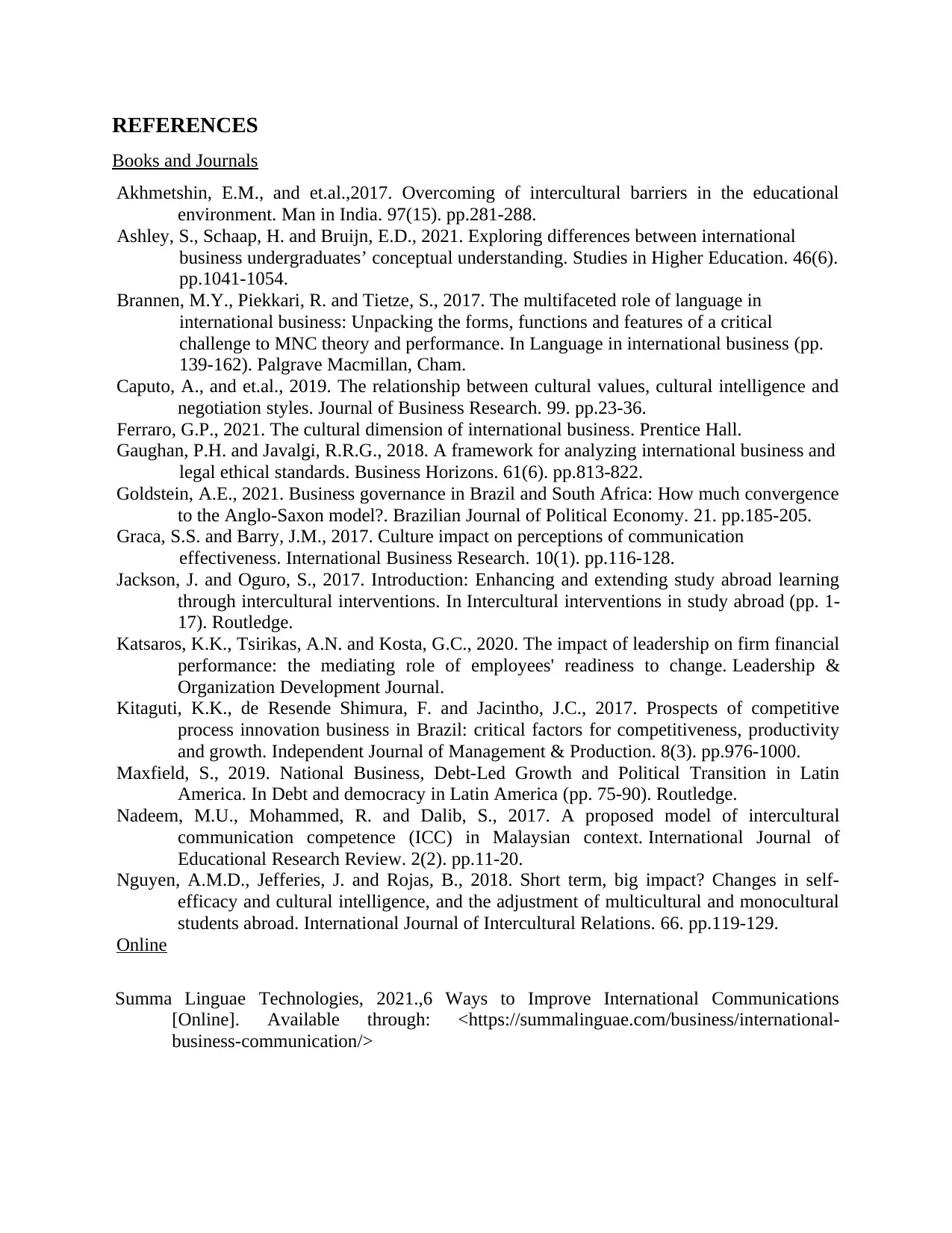
REFERENCES
Books and Journals
Akhmetshin, E.M., and et.al.,2017. Overcoming of intercultural barriers in the educational
environment. Man in India. 97(15). pp.281-288.
Ashley, S., Schaap, H. and Bruijn, E.D., 2021. Exploring differences between international
business undergraduates’ conceptual understanding. Studies in Higher Education. 46(6).
pp.1041-1054.
Brannen, M.Y., Piekkari, R. and Tietze, S., 2017. The multifaceted role of language in
international business: Unpacking the forms, functions and features of a critical
challenge to MNC theory and performance. In Language in international business (pp.
139-162). Palgrave Macmillan, Cham.
Caputo, A., and et.al., 2019. The relationship between cultural values, cultural intelligence and
negotiation styles. Journal of Business Research. 99. pp.23-36.
Ferraro, G.P., 2021. The cultural dimension of international business. Prentice Hall.
Gaughan, P.H. and Javalgi, R.R.G., 2018. A framework for analyzing international business and
legal ethical standards. Business Horizons. 61(6). pp.813-822.
Goldstein, A.E., 2021. Business governance in Brazil and South Africa: How much convergence
to the Anglo-Saxon model?. Brazilian Journal of Political Economy. 21. pp.185-205.
Graca, S.S. and Barry, J.M., 2017. Culture impact on perceptions of communication
effectiveness. International Business Research. 10(1). pp.116-128.
Jackson, J. and Oguro, S., 2017. Introduction: Enhancing and extending study abroad learning
through intercultural interventions. In Intercultural interventions in study abroad (pp. 1-
17). Routledge.
Katsaros, K.K., Tsirikas, A.N. and Kosta, G.C., 2020. The impact of leadership on firm financial
performance: the mediating role of employees' readiness to change. Leadership &
Organization Development Journal.
Kitaguti, K.K., de Resende Shimura, F. and Jacintho, J.C., 2017. Prospects of competitive
process innovation business in Brazil: critical factors for competitiveness, productivity
and growth. Independent Journal of Management & Production. 8(3). pp.976-1000.
Maxfield, S., 2019. National Business, Debt-Led Growth and Political Transition in Latin
America. In Debt and democracy in Latin America (pp. 75-90). Routledge.
Nadeem, M.U., Mohammed, R. and Dalib, S., 2017. A proposed model of intercultural
communication competence (ICC) in Malaysian context. International Journal of
Educational Research Review. 2(2). pp.11-20.
Nguyen, A.M.D., Jefferies, J. and Rojas, B., 2018. Short term, big impact? Changes in self-
efficacy and cultural intelligence, and the adjustment of multicultural and monocultural
students abroad. International Journal of Intercultural Relations. 66. pp.119-129.
Online
Summa Linguae Technologies, 2021.,6 Ways to Improve International Communications
[Online]. Available through: <https://summalinguae.com/business/international-
business-communication/>
Books and Journals
Akhmetshin, E.M., and et.al.,2017. Overcoming of intercultural barriers in the educational
environment. Man in India. 97(15). pp.281-288.
Ashley, S., Schaap, H. and Bruijn, E.D., 2021. Exploring differences between international
business undergraduates’ conceptual understanding. Studies in Higher Education. 46(6).
pp.1041-1054.
Brannen, M.Y., Piekkari, R. and Tietze, S., 2017. The multifaceted role of language in
international business: Unpacking the forms, functions and features of a critical
challenge to MNC theory and performance. In Language in international business (pp.
139-162). Palgrave Macmillan, Cham.
Caputo, A., and et.al., 2019. The relationship between cultural values, cultural intelligence and
negotiation styles. Journal of Business Research. 99. pp.23-36.
Ferraro, G.P., 2021. The cultural dimension of international business. Prentice Hall.
Gaughan, P.H. and Javalgi, R.R.G., 2018. A framework for analyzing international business and
legal ethical standards. Business Horizons. 61(6). pp.813-822.
Goldstein, A.E., 2021. Business governance in Brazil and South Africa: How much convergence
to the Anglo-Saxon model?. Brazilian Journal of Political Economy. 21. pp.185-205.
Graca, S.S. and Barry, J.M., 2017. Culture impact on perceptions of communication
effectiveness. International Business Research. 10(1). pp.116-128.
Jackson, J. and Oguro, S., 2017. Introduction: Enhancing and extending study abroad learning
through intercultural interventions. In Intercultural interventions in study abroad (pp. 1-
17). Routledge.
Katsaros, K.K., Tsirikas, A.N. and Kosta, G.C., 2020. The impact of leadership on firm financial
performance: the mediating role of employees' readiness to change. Leadership &
Organization Development Journal.
Kitaguti, K.K., de Resende Shimura, F. and Jacintho, J.C., 2017. Prospects of competitive
process innovation business in Brazil: critical factors for competitiveness, productivity
and growth. Independent Journal of Management & Production. 8(3). pp.976-1000.
Maxfield, S., 2019. National Business, Debt-Led Growth and Political Transition in Latin
America. In Debt and democracy in Latin America (pp. 75-90). Routledge.
Nadeem, M.U., Mohammed, R. and Dalib, S., 2017. A proposed model of intercultural
communication competence (ICC) in Malaysian context. International Journal of
Educational Research Review. 2(2). pp.11-20.
Nguyen, A.M.D., Jefferies, J. and Rojas, B., 2018. Short term, big impact? Changes in self-
efficacy and cultural intelligence, and the adjustment of multicultural and monocultural
students abroad. International Journal of Intercultural Relations. 66. pp.119-129.
Online
Summa Linguae Technologies, 2021.,6 Ways to Improve International Communications
[Online]. Available through: <https://summalinguae.com/business/international-
business-communication/>
1 out of 10
Related Documents
Your All-in-One AI-Powered Toolkit for Academic Success.
+13062052269
info@desklib.com
Available 24*7 on WhatsApp / Email
![[object Object]](/_next/static/media/star-bottom.7253800d.svg)
Unlock your academic potential
Copyright © 2020–2025 A2Z Services. All Rights Reserved. Developed and managed by ZUCOL.


